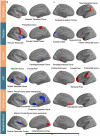Pattern learning reveals brain asymmetry to be linked to socioeconomic status
- PMID: 35702547
- PMCID: PMC9188625
- DOI: 10.1093/texcom/tgac020
Pattern learning reveals brain asymmetry to be linked to socioeconomic status
Abstract
Socioeconomic status (SES) anchors individuals in their social network layers. Our embedding in the societal fabric resonates with habitus, world view, opportunity, and health disparity. It remains obscure how distinct facets of SES are reflected in the architecture of the central nervous system. Here, we capitalized on multivariate multi-output learning algorithms to explore possible imprints of SES in gray and white matter structure in the wider population (n ≈ 10,000 UK Biobank participants). Individuals with higher SES, compared with those with lower SES, showed a pattern of increased region volumes in the left brain and decreased region volumes in the right brain. The analogous lateralization pattern emerged for the fiber structure of anatomical white matter tracts. Our multimodal findings suggest hemispheric asymmetry as an SES-related brain signature, which was consistent across six different indicators of SES: degree, education, income, job, neighborhood and vehicle count. Hence, hemispheric specialization may have evolved in human primates in a way that reveals crucial links to SES.
Keywords: brain lateralization; hemispheric asymmetry; machine learning; multi-output pattern learning; population neuroscience; socioeconomic status.
© The Author(s) 2022. Published by Oxford University Press.
Figures





References
-
- Adler NE, Boyce T, Chesney MA, Cohen S, Folkman S, Kahn RL, Syme SL. Socioeconomic status and health. The challenge of the gradient. Am Psychol. 1994:49:15–24. - PubMed
-
- Baker EH. Socioeconomic status, definition. In: Cockerham WC, Dingwall R, Quah SR, editors. The Wiley Blackwell Encyclopedia of health, illness, behavior, and society. John Wiley & Sons, Ltd.; 2014
-
- Boles DB. Socioeconomic status, a forgotten variable in lateralization development. Brain Cogn. 2011:76:52–57. - PubMed
-
- Borchani H, Bielza C, Martinez-Martin P, Larranaga P. Markov blanket-based approach for learning multi-dimensional Bayesian network classifiers: an application to predict the European quality of Life-5 dimensions (EQ-5D) from the 39-item Parkinson's disease questionnaire (PDQ-39). J Biomed Inform. 2012:45:1175–1184. - PubMed
Grants and funding
LinkOut - more resources
Full Text Sources
